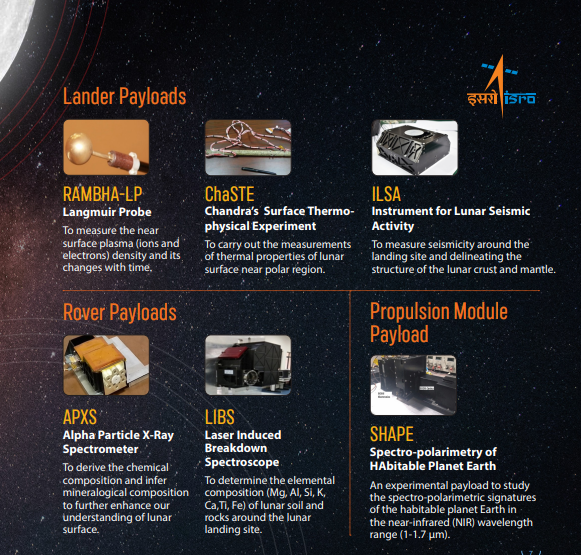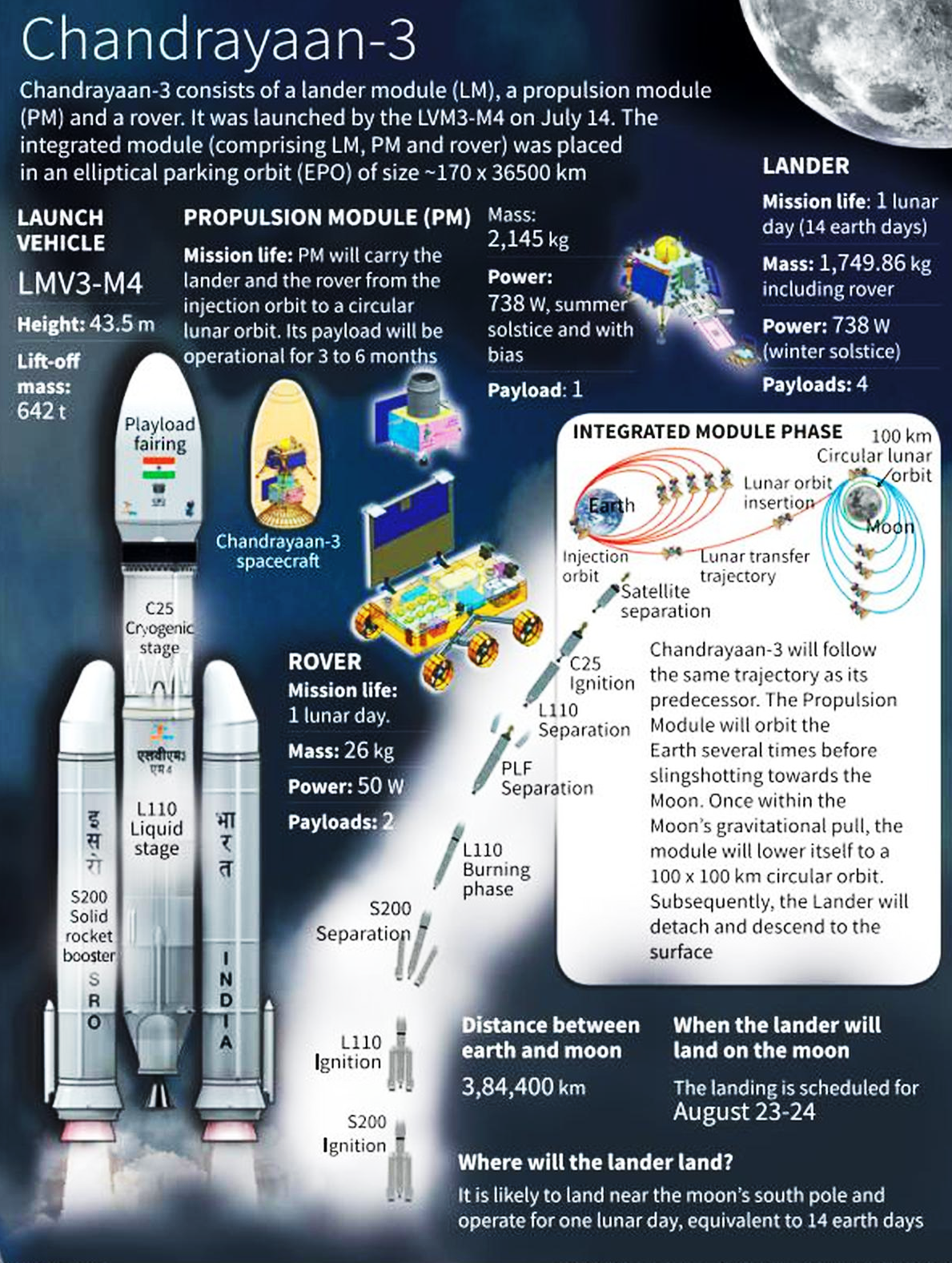Chandrayaan-3
2023 JUL 20
Mains >
Science and Technology > Space technology > Space organisations & missions
IN NEWS:
- India’s third moon mission, Chandrayaan-3, was successfully launched onboard a Launch Vehicle Mark-3 (LVM-3) rocket from the Satish Dhawan Space Centre in Sriharikota on July 14, 2023.
- This is India’s second attempt at soft-landing robotic instruments on the lunar surface after the previous attempt, Chandrayaan-2, failed in 2019.
- If everything goes well, Chandrayaan-3 will be the world’s first mission to soft-land near the lunar south pole. All the previous spacecraft have landed a few degrees north or south of the lunar equator.
ABOUT CHANDRAYAAN-3:
- Features:
- Chandrayaan-3 is a follow-on mission to Chandrayaan-2 to demonstrate end-to-end capability in safe landing and roving on the lunar surface.
- It consists of an indigenous Lander module (LM), Propulsion module (PM) and a Rover with an objective of developing and demonstrating new technologies required for Inter planetary missions.
- The propulsion module is the one that will take the lander and the rover to the moon. This module does not land on the moon and instead settles on a parking orbit of 100 km x 100 km around the moon. The lander and rover, on the other hand, will separate from the propulsion module to land on the moon.
- The Lander will have the capability to soft land at a specified lunar site and deploy the Rover which will carry out in-situ chemical analysis of the lunar surface during the course of its mobility.
- The Lander and the Rover have scientific payloads to carry out experiments on the lunar surface.

- Objectives of the mission:
- To demonstrate Safe and Soft Landing on Lunar Surface
- To demonstrate Rover roving on the moon and
- To conduct in-situ scientific experiments.

WHY ISRO WANTS TO EXPLORE THE MOON’S SOUTH POLE:
- Presence of water:
- Due to their rugged environment, the polar regions of the Moon have remained unexplored. But several Orbiter missions have provided evidence that these regions could be very interesting to explore, and there are indications of the presence of ice molecules in substantial amounts in the deep craters in this region.
- For instance, in a 2019 report, NASA said that water that happens to find its way into Permanently Shadowed Regions, or PSRs, may remain there for long periods of time. Also, India’s 2008 Chandrayaan-1 mission indicated the presence of water on the lunar surface with the help of its two instruments onboard.
- Unlike the Earth, whose spin axis is tilted with respect to the plane of the Earth’s solar orbit by 23.5 degrees, the Moon’s axis tilts only 1.5 degrees. Because of this unique geometry, sunlight never shines on the floors of a number of craters near the lunar north and south poles. These areas are known as Permanently Shadowed Regions, or PSRs.
|
- Clues to the early solar system:
- The extremely cold temperatures at the poles mean that anything trapped in the region would remain frozen in time without undergoing much change.
- The rocks and soil at the moon’s north and south poles could therefore provide clues to the early Solar System.
CHALLENGES ASSOCIATED WITH SOFT-LANDING:
- Autonomous process of touch down:
- The ISRO Chief called the 15-minute duration of the soft landing "15 minutes of terror," when the lander has to fire its engines at the right times and at the right altitudes, use just the right amount of fuel, make accurate scans of the lunar surface’s hills and craters, and finally touch down.
- Soft-landing a lunar module means going from the screaming speeds of over 6,000 km/h to zero.
- The whole process is autonomous, meaning the ISRO cannot do much to guide the lander from Earth.
- Lunar dust:
- The lander soft-lands on the moon using its thrusters to control its descent speed.
- When touching down, the lander’s thrusters blast lunar dust off the surface at high speeds.
- This can obscure the camera lens and trigger faulty readings.
SIGNIFICANCE OF THE MISSION:
- Boost country's first human spaceflight programme:
- The successful launch of Chandrayaan-3 has given a major boost to the country's first human spaceflight programme, as the LVM3 rocket, which carried Chandrayaan-3, would be used for the launch of the ambitious Gaganyaan mission with 'human-rated' capability.
- For the Gaganyaan programme, the LVM3 rocket is re-configured to meet the human rating requirements and has been christened as 'Human Rated LVM3'.
- Space and planetary exploration as new priorities:
- Chandrayaan 3, Mangalyaan, and the upcoming mission Gaganyaan show that space and planetary exploration are new priorities for ISRO, which earlier focused on utilitarian objectives such as enabling telecommunications, telemedicine, and tele-education, broadcasting, or setting up remote sensing satellites.
- For instance, the Lander Module (LM), Propulsion Module (PM), and Rover in Chandrayaan 3 also have the objective of developing and demonstrating new technologies required for interplanetary missions.
- Private participation in the space sector:
- Several public and private sector units all over the country played an active role in the Chandrayaan-3 mission. For instance, Mishra Dhatu Nigam Limited (MIDHANI), the defence PSU, had developed and supplied various critical and strategic materials for the three-stage heavy-lift launch vehicle.
- Thus, the success of the mission will further the government's objectives of private participation in the space sector and defence indigenization.
- Stay ahead in the ‘race for space’:
- Space is slowly yet steadily becoming the next front in warfare. Also, space technologies are becoming a fundamental part of defence technologies in the form of quantum-encrypted communication and advanced air defence systems.
- Hence, missions like Chandrayaan, Gaganyaan, etc. will help India have a strong presence in space, which will be strategically vital for the country in the coming years.
CONCLUSION:
- Space is no longer a benign exercise in the pursuit of science. It has extremely important strategic, economic, and even military dimensions. It brings concrete power advantages. It is no coincidence that every major power in the world is also a major space-faring nation. That is why it is so crucial that ISRO moves ahead quickly in this new phase with missions including Chandrayaan, Gaganyaan, etc. by widening the horizons.
PRACTICE QUESTION:
Q. “Beyond exploring Earth's moon, the Chandrayaan-3 mission is a steppingstone towards ISRO's future interplanetary missions and other endeavours”. Discuss.

